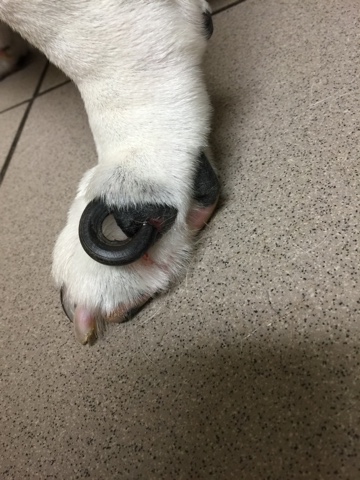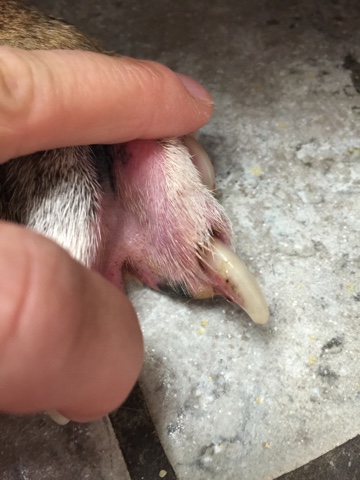 |
| Classic "non-weight bearing" stance of a dog with a dislocated hip. |
 |
| Two weeks post-op knee surgery and a seated dog with a bent knee proves that the joint is happy and healing. |
One of the most common questions we get on Pawbly.com is about the limping dog.
To help people at home understand some of the most common injuries that cause lameness in a pet I thought I would provide a very basic "How to examine your limping dog at home" instruction blog.
Remember an examination doesn't just include the affected limb, it must include the whole pet. For this reason I recommend starting at the tip of the nose and letting your hands walk slowly from the nose to the tail. Inspecting everything very closely along the way.
Then we go to the "off" leg.
In most of these cases I advise my clients to check the leg by palpating (using your fingers to be your guide) and examining very closely everything as your fingers walk your way over the leg from the toes to the spine. Palpate and probe every inch 360 degrees around as you move gradually up the leg. I know that most dogs are not fond of the feet (toes especially) being poked and prodded but in lots of cases the answer lies somewhere around here.
It is also important to remember symmetry. Use the opposite leg as a guide for what "normal" should look like.
Here we go on our virtual tour up the leg..
Then we go to the "off" leg.
In most of these cases I advise my clients to check the leg by palpating (using your fingers to be your guide) and examining very closely everything as your fingers walk your way over the leg from the toes to the spine. Palpate and probe every inch 360 degrees around as you move gradually up the leg. I know that most dogs are not fond of the feet (toes especially) being poked and prodded but in lots of cases the answer lies somewhere around here.
It is also important to remember symmetry. Use the opposite leg as a guide for what "normal" should look like.
Here we go on our virtual tour up the leg..
1. Check toenails. Some have grown into the pad and some are broken. All are painful. Broken toenails should be trimmed or clipped back as far as possible, or even removed, if broken severely. At the clinic I use a topical numbing agent and a muzzle and a quick cut. It hurts for one second,, like pulling off a band-aid. Then the pet is pain free again and using the leg as normal.
 |
| A very sharply pointed nail had grown into the foot pad. When trimmed the evidence of the puncture is evident. |
 |
| This pups toe required twice daily soaks and an oral antibiotic. This must be treated as a wound. |
 |
| Clipped short enough to not touch the floor and cause pain. Yellow styptic powder was used to stop the bleeding. |
 |
| The toenail was broken, removed and leaves the "quick" exposed. But, it will no longer be painful and the limp will cease. Keeping the nail bed clean is all that is needed, No Licking! |
2. Look for redness or swelling, or wet, moist skin in between the toes. Some dogs get allergies, infections, even splinters in between their toes.
 |
| Interdigital cysts are painful. This causes the pet to lick, which inflames the skin and seeds infection. |
 |
| Many dogs with allergies lick their feet because they itch. The licking causes red staining, inflamed skin and infection. |
3. Look for injury to the foot pads. If bleeding soak foot in warm very mildly soapy water for a few minutes, then apply direct pressure with a clean cloth for 10 minutes,, no peeking, no wiping, no tight bandages. A small laceration to the foot pad is usually just allowed to heal. A deep laceration (full skin thickness) usually requires and antibiotic and protection from further trauma ( i like a panti liner (absorbs small amounts of blood and is super cheap) and a sock.. but change at least twice a day. Please call your vet if the wound is deep.
4. Look for any skin damage. Areas of injury. All penetrating wounds need veterinary assistance for an antibiotic and in some cases exploration to make sure nothing internal is damaged.
5. Broken bones cause significant non-weight bearing lameness and usually have considerable swelling. I know lots of people worry about broken bones but they are not normally seen without significant trauma like hit by car, jumping off bed, etc. They are swollen, painful and the leg often looks disfigured. Do not touch a broken leg without a muzzle in place. If the bone is sticking out of the skin wrap the leg in a towel and get to a vet to help stop the bleeding.
 |
| Maci a few days after her cruciate repair surgery. |
I always advise that every limping and lame dog be kept quiet and calm by leashing walking outside at all times, or crating until your vet can see you. No running, jumping or play. Rest the leg. In many cases that is the only needed treatment.
A dog in significant pain to the point of not using the leg, being reluctant to stand or walk, or not interested in play, interaction, or even eating needs a vet immediately. In general a limping dog is not an emergency unless they are bleeding excessively, progressively worsening, or having a change in attitude or behavior.
In all cases your vet should be consulted. There are lots of options available after a diagnosis is provided.
As always you can ask me a question about your limping (or otherwise) pet anytime for free on Pawbly.com. Pawbly is free to use and open to anyone and everyone.
Twitter has me sporadically @FreePetAdvice, And the whole majority of the rest of my life has me at the veterinary clinic, Jarrettsville Veterinary Center in Jarrettsville Maryland.
Twitter has me sporadically @FreePetAdvice, And the whole majority of the rest of my life has me at the veterinary clinic, Jarrettsville Veterinary Center in Jarrettsville Maryland.








Great advice and great pictures. I appreciate your attempts to education pet owners like myself.
ReplyDeleteThank you for reading! And for all you do to help pups everywhere!
DeleteExcellent photos and advice. Harley's been licking his paws since we arrived in SC. Vet says it's allergies, I keep my eyes on them so far the topical spray I'm using is helping.
ReplyDeleteHere's to hoping that the paws keep improving! Thanks for all of the excellent work you do! XOXO to all!
Deletethanks
ReplyDeleteHi Krista, Great job you did here. I was wondering for the information you gathered here on this beautiful page. I did not know much more about limping dog. The different limping issue like Broken toenails, infections, allergies lick, skin damage you explained is really very help-worth. I like this type of beneficial work. Thanks a lot for your great contribution. dog tail wound infection
ReplyDelete